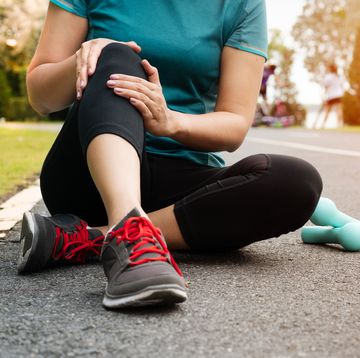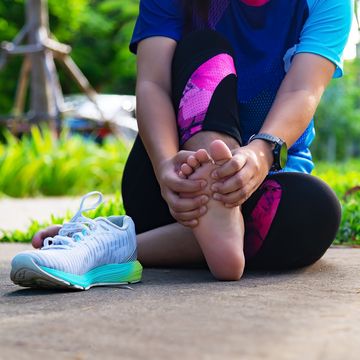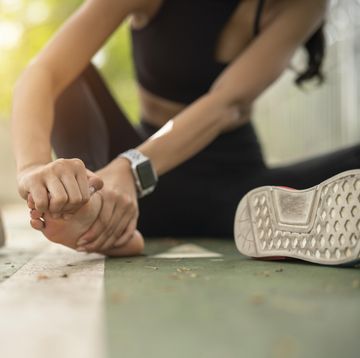If you suspect you have a meniscus tear – or have received a recent diagnosis – as a runner, you're likley worrying about two things: 1) what this means for your running and 2) if you're going to need surgery.
The good new is: tearing your meniscus does not necessarily mean you require surgery. And whether you manage your symptoms conservatively or require surgery, there is a very good chance you’ll be able to return to running.
Here, chartered physiotherapist Matt Bergin unpacks everything you need to know about meniscus tears, including how they're caused, key symptoms to look out for, how to get diagnosed, and most importantly, your best treatment options.
What everyone's reading
Where is your meniscus located – and what exactly is it?
Our knee joint is formed by the surfaces of the plateau of the tibia (top of shin bone) and condyles of the femur (ends of the thigh bone). Overlying both surfaces is a thin layer of articular cartilage. Where the tibia is different is that it also hosts a spongy, rubber-like structure known as the meniscus – another type of cartilage that sits on top of the articular cartilage.
The meniscus is comprised of two parts: the medial (inside) meniscus is C-shaped while the lateral (outside) is more circular. Viewed cross-sectionally they are wedge-shaped, thicker on the outside and thinner towards the inside, with only the outer 10-30%, known as the ‘red area’, receiving a good blood supply.
The menisci have several functions, most importantly to provide shock absorption and load distribution across the joint surfaces as we walk and run. They also provide protection to the underlying articular cartilage of the tibia, as well as providing some lubrication to the knee joint and proprioception (balance and stability).
Injury to the meniscus can compromise its ability to distribute load when running, leaving the knee more vulnerable to developing further issues if not managed carefully.
How are meniscus tears caused?
Traumatic tears
These occur secondary to trauma to the knee, where there is often an obvious ‘ouch’ moment. Twisting and pivoting movements with the foot planted are the most stressful for the meniscus – football, netball, rugby and basketball are some of the most common sports where these injuries tend to occur.
Degenerative tears
Meniscus tears can occur as part of the ageing process. As we age, the meniscus becomes less rubbery and weaker. Degenerative tears often develop alongside other degenerative joint changes associated with osteoarthritis – bony spurs, cartilage thinning and damage to the underlying bone surfaces.
Tears are categorised based on their size, location and pattern, with the medial meniscus most typically effected.
What are the symptoms of a meniscus tear?
Common symptoms include: catching, locking, giving way and swelling. Discomfort along the joint line will often be present, dependent on the location of the tear. Limitation in range of movement that worsens after periods of inactivity is another common feature. Symptoms may come and go but will typically be aggravated by twisting and turning movements.
Despite this, not all meniscus injuries will cause pain or symptoms at all. In one study, 115 pain-free individuals were scanned via MRI and 97% demonstrated knee abnormalities, which included 31% meniscal tears.
With degenerative tears, my experience with runners has shown me that poor trunk and lower limb strength, as well as poorly controlled movement patterns when running, can increase someone’s likelihood of developing symptoms. This is because a lack of strength will impact the ability of the meniscus to effectively absorb and distribute load across the joint surfaces, which over time may increase the risk of developing degenerative tears, or developing symptoms if a tear is present.
How is a meniscus tear diagnosed – when should I see a physio?
If a recent knee injury has occurred and you are experiencing symptoms of locking, giving-way, stiffness, or swelling, this is the time to visit a chartered physiotherapist or a consultant orthopaedic surgeon. Similarly, if over the recent weeks and months symptoms in your knee have been deteriorating and you’re beginning to experience any of the above symptoms, now is the time to seek an expert assessment.
All diagnosis' should be made through a combined approach; considering the history of the injury, your symptoms, and these correlated with findings from a thorough assessment of the knee. MRI imaging can also be used to determine the exact location and severity of the injury. However, we must determine if the findings on imaging are clinically relevant (ie, is what the MRI shows relevant to your pain and symptoms?) MRI scans can be obtained both through referral via the NHS or privately, through companies such as Vista Health.
As part of the physical assessment of the knee, there are several provocative tests that aim to stress the meniscus and assist in the diagnosis of a meniscus tear. The most common tests are known as the McMurray’s test, Apley’s test and Thessaly’s test, with reproduction of pain or your symptoms being deemed a positive test. Findings from these tests will contribute to the overall decision-making process, rather than dictate whether treated conservatively or surgically.
What are your best treatment options if you have been diagnosed with a meniscus tear?
Just like when diagnosing a meniscus tear, treatment options should be determined through a combined approach, and as part of a multi-disciplinary team, consisting of your physiotherapist, consultant orthopaedic consultant and your GP. Decisions on whether to manage the tear conservatively or through surgery will be determined largely by your symptoms and current function, as well as the location, severity, and type of the meniscus tear. Your age, weight, past medical history, lifestyle, sport and long-term goals will also be considered.
Can you heal a torn meniscus naturally?
I often get asked if a torn meniscus can heal naturally. This is largely determined by the location of the tear. A tear to the outer ‘red zone’ of the meniscus has a better blood supply than the more central ‘white zone’ and therefore has a better chance at healing naturally. In these instances, conservative management might be your first port of call.
If you’re symptoms are quite mild, you’re not experiencing any locking, giving way or catching sensations, and your function is good, the decision to manage things conservatively might be made initially.
This is where physiotherapists come in. Working on the mobility, strength and control of the knee would be our focus, which will enable the knee to function as a shock absorber more effectively when walking and running.
If conservative treatments have failed, or the severity and location of your meniscus tear are determined to be best managed with surgery, you will likely undergo an arthroscopic procedure. This is where the surgeon uses a small camera, called an arthroscope, to view the structures within the knee. Depending on the findings, they may then perform a meniscectomy where they remove the damaged areas of tissue, or they may decide to perform a meniscus repair. These tend to have a longer recovery time.
Can you get surgery through the NHS?
Yes, you can get this done through the NHS. Physiotherapists, whether in the private setting or the NHS, will have the ability to refer you to an orthopaedic consultant surgeon if deemed necessary. A lot of the surgeons we deal with will work both privately and within the NHS, so even if you go privately, you may still see the same surgeon.
Will surgery resolve my symptoms – and allow me to run again pain free?
Surgery alone will not necessarily resolve your issues in the long term – rehabilitation is equally, if not more, important. Surgery may remove or repair the area of damaged meniscus, but it will not, in the case of the degenerative tears, resolve any of the underlying causes – the muscle weakness and dysfunctional movement patterns.
Whether you manage your symptoms conservatively or require surgery, it is vital that you work with an experienced physiotherapist to ensure you regain full mobility and function in the knee, before working on your strength, control, balance, eventually progressing to running-specific rehab.
Should you still run if you have a meniscus tear?
My advice would be to listen to your symptoms. If you can walk for long distances with no aggravation in your symptoms and you can squat, lunge, and hop on one leg with no compensations, no increase in your pain levels and no swelling, I would recommend a gradual re-introduction to running. A walk-run program would be most appropriate here. However, continue to monitor your symptoms and adjust the frequency, duration and intensity of your runs depending on how your knee responds.
There is very little evidence to suggest that running is a risk factor for developing acute meniscus tears, largely due to the lack of twisting and turning involved when we run. However, if you like running off road, on the trails and up and down mountains, this may increase your risk.
What are the best exercises you can do for a meniscus tear?
Exercise prescription for meniscus tears must be targeted to the individual, there is no one-size-fits-all here. Pain is your guide – and the idea is to avoid it completely. Don’t try to push through any pain as this will simply worsen things. No aggravation of your symptoms during or after exercise is the guide.
Alongside the strengthening, we must also ensure you have sufficient range of motion at the knee joint into both extension (straightening) and flexion (bending), to allow for efficient load absorption when walking and running. Stiffness into either of these movements will alter where, and how, the loads are distributed, potentially leading to further issues down the line if left unresolved.
Strengthening
Perform one of the strength exercises below daily:
Double-leg wall squat
- Stand with your back flat against a wall, feet shoulder-width apart and your heels roughly 40-50cm away from the wall.
- Slowly slide your back down the wall, only going as low as is comfortable – do not go below 90 degrees!
- Ensure your knees are aligned over your middle toes and not drifting inwards.
- Keep your back flat against the wall and hold the position. Start with 15-20 seconds initially, progressing to 45-60 seconds as you feel able.
- Repeat this 3 times. Perform this once daily.
Progression
To make things more difficult perform the double leg wall squat as before, but once in the squat position, raise the heel of one foot off the floor. Hold the position for 5 seconds before switching legs. Repeat this for a total of 30 seconds initially, progressing to 60 seconds as you feel able.
Split squat
- From a standing position, take a step forward so that you are in a split stance position. Ensure both feet are facing forwards, the heel of your back foot is raised off the ground and each foot is underneath the corresponding hip (avoid performing as though on a tight rope!).
- From here, slowly drop the back knee straight down towards the ground until your shin is roughly parallel with the ground, or as low as is comfortable for your knee.
- Ensure you remain up tall through your trunk and your front knee does not travel beyond the end of your toes. Focus on the alignment of your front knee over the middle of your foot, ensuring the knee does not collapse inwards.
- Perform 10-12 repetitions, for 2-3 sets.
- Do this move four times per week.
Movement Control
Perform one control exercise from the following daily:
Gluteus medius wall hold
- Stand side on to a wall, with your outermost foot roughly 30-40cm away from the wall. Ensure your foot is pointing forwards, parallel to the wall.
- Rest the opposite leg against the wall, ensuring only the outer knee and shin are in contact with it. Do not lean your waist and body against the wall.
- Slightly bend your standing knee and keep the knee aligned over roughly the third and fourth toes. Hold this position.
- You should start to feel the burn in the outer gluteal muscles on the standing leg. If you do not, check that your foot is facing forwards and hasn’t turned outwards.
- Hold for 30-45 seconds, repeat 3 times.
- Perform once daily.
Lateral step up & down
- Stand on a step side-ways on, holding on with fingertips if needed for balance, with the other foot hovering over the edge of the step.
- Slowly lower the free foot towards the ground, bending from the knee on the standing leg. Ensure the knee that is bending is aligned over the third and fourth toe throughout the movement and does not travel beyond the end of the toes.
- From here push through the standing leg and straighten back up, controlling the knee position throughout.
- Only lower as far as is comfortable in the knee.
- Perform 2-3 sets of 10-15 repetitions. Perform once daily.
To make things more challenging, raise up into a high-knee position as you straighten back up, as if coming up into a running position. Use the arms as well.
Calf raises
Both the gastrocnemius and deeper soleus muscle have roles in knee function, as we absorb the forces when first landing and transitioning through to the point of toe-off.
Straight-leg calf raise
- Stand nice and upright, by a step or raised area. You can create your own at the gym by using a weight plate. Make sure your shoulders are back and your posture is good.
- Place the balls of your feet on the step or plate, making sure that your heels 'hang' off the back and are not touching the floor.
- Keeping your feet still and toes still pointing forwards, raise your heels, contracting your calves. Slowly lower back down to the starting position.
- Repeat on the other leg.
- Complete 3 sets of 25-30 repetitions. These can be done daily.
Bent-leg calf raise
- Stand nice and upright, by a step or raised area. You can create your own at the gym by using a weight plate. Make sure your shoulders are back and your posture is good.
- Stand on one leg and bend your knee to as close to 90 degrees as you can.
- Raise your heel and then slowly lower back down till you get a stretch in the calf and repeat.
- Repeat on the other leg.
- Complete 3 sets of 25-30 repetitions. These can be done daily.
Before looking towards a return to a running programme, we need to progress to more dynamic and plyometric-type exercises, such as double-leg hopping, jumping and then single-leg hops and skips, to expose the knee to the stresses and loads it will be placed under when running.

Chartered Physiotherapist
Matt is an international middle-distance runner with a keen interest in running-related injuries, rehabilitation and prehabilitation.
























